This post may contain affiliate links. Please read our disclosure policy.
Shanghai rice cake stir fry with napa cabbage and bok choy is a one-pot meal loaded with veggies, flavor, and pleasing textures. Chewy and sticky rice cakes combine with umami-rich shitake, sweet napa cabbage, and crispy baby bok choy in a sweet and savory sauce.
Inspired by Din Tai Fung Shanghai rice cake recipe, this vegan stir fry is simple yet delicious. It’s perfect for a family meal anytime, but it’s traditionally a Chinese New Year dish said to bring prosperity!
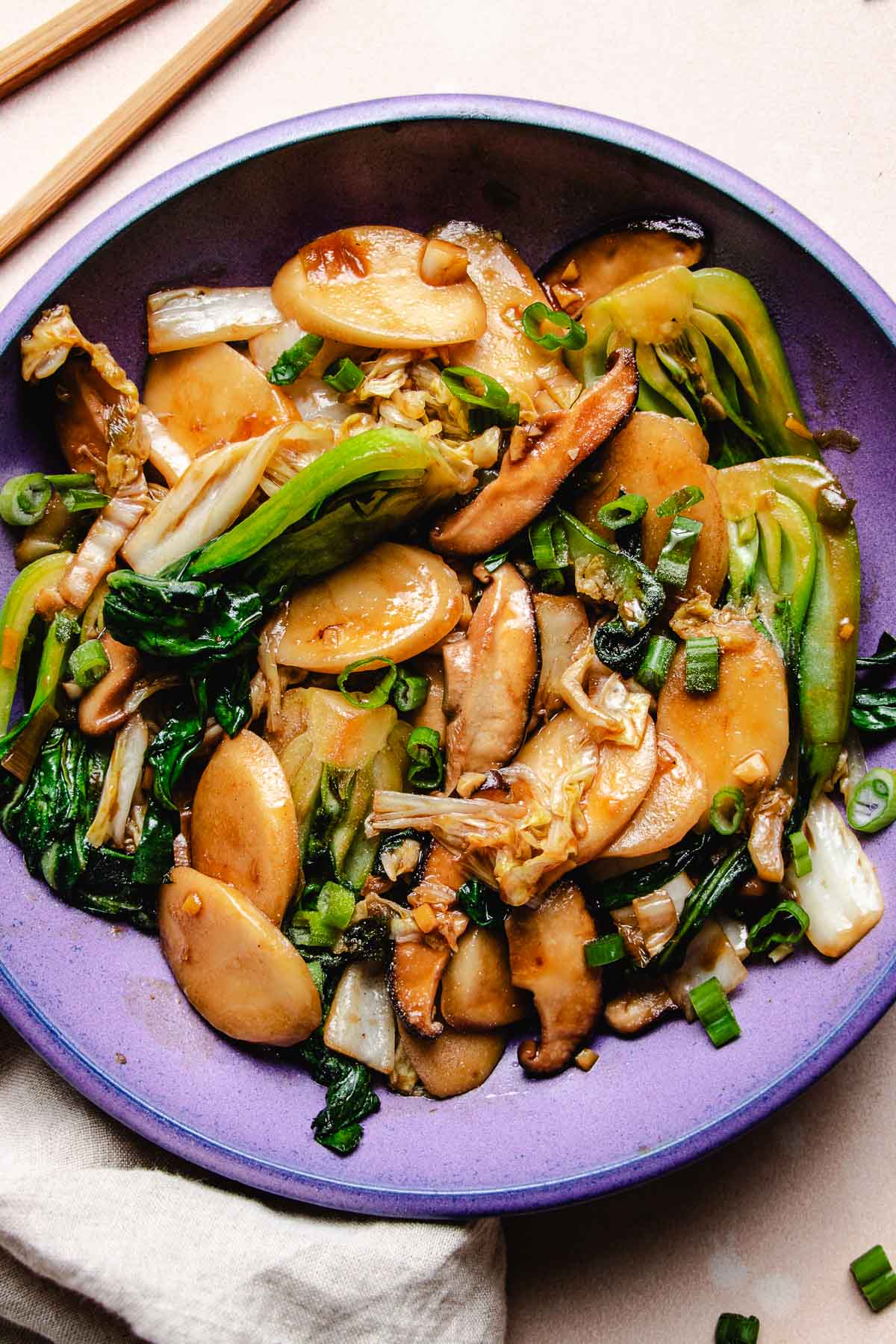
Table of Contents
- What is a Chinese rice cake?
- How to select and prepare Shanghai rice cakes
- Ingredients
- How to cook Shanghai rice cake din tai fung style
- How to make ahead, store, and reheat
- What to serve with stir fried rice cake
- Expert tips
- FAQs
- More Chinese one-pan meals you might like
- Shanghai rice cake recipe with napa cabbage and bok choy
What is a Chinese rice cake?
Chinese rice cake, also known as Shanghai rice cakes or nian gao, is a unique culinary delight. They are traditionally made from rice flour, tapioca starch, sugar, salt, and water. The key to their distinctive texture is the use of wet-milled Thai rice flour.
This flour is created from white rice grains that are first soaked and then ground into an ultra-fine, silky powder. As a result, the rice cakes have a smooth, chewy, and silky taste. I use the same flour to make my gluten-free wonton wrappers.
n contrast to Korean rice cakes, which are typically shaped into cylinders, Chinese rice cakes are sliced into thin, ovals. This makes them ideal for a variety of savory dishes. Wondering what to make with rice cakes? There are many rice cake recipes in which you can boil, steam, fry, stir fry, or incorporate them into soups or even a Vegan hot pot.
How to select and prepare Shanghai rice cakes
When looking for the perfect Asian rice cakes for your stir fry, you’ll find them in Chinese and Korean grocery stores. Specifically, for stir-frying, we use Shanghai-style rice cakes (also known as Chinese rice cakes).

Save This Recipe
There are different methods to prepare rice cakes, depending on their packaging.
- Boil Directly (Most Common and Convenient): Boiling is the most common method to prepare rice cakes, usually taking about 3-4 minutes in hot water to soften them. You don’t need to pre-soak or thaw them first. This approach is ideal for three types of rice cakes:
- Fresh rice cakes,
- Rice cakes stored in vacuum-sealed bags found in the refrigerator aisle,
- Frozen rice cakes.
- Pre-Soaking Required: If you find dry rice cakes in packages, that are shelf-stable and not refrigerated, they will feel firm, dry, and dense. These rice cakes need to be soaked for at least 30 minutes in warm water before cooking to rehydrate them properly.
- My favorite types of Shanghai rice cakes are either fresh or refrigerated in vacuum-sealed bags.
Tip: The best way to determine how to cook rice cakes is to refer to the package instructions, as manufacturers often list out the ideal preparation methods. Also, gently separate each rice cake slice with your hands before cooking or soaking them. This ensures each oval rice cake is cooked evenly, achieving the perfect chewy and silky texture.
Ingredients
This rice cake Chinese stir fry uses store-bought sliced rice cake and minimal, accessible ingredients to achieve a wonderfully textured and flavorful dish with ease. Chewy and subtly sweet stir-fried rice cakes marry perfectly with mushrooms and greens in an aromatic sweet and sour sauce.
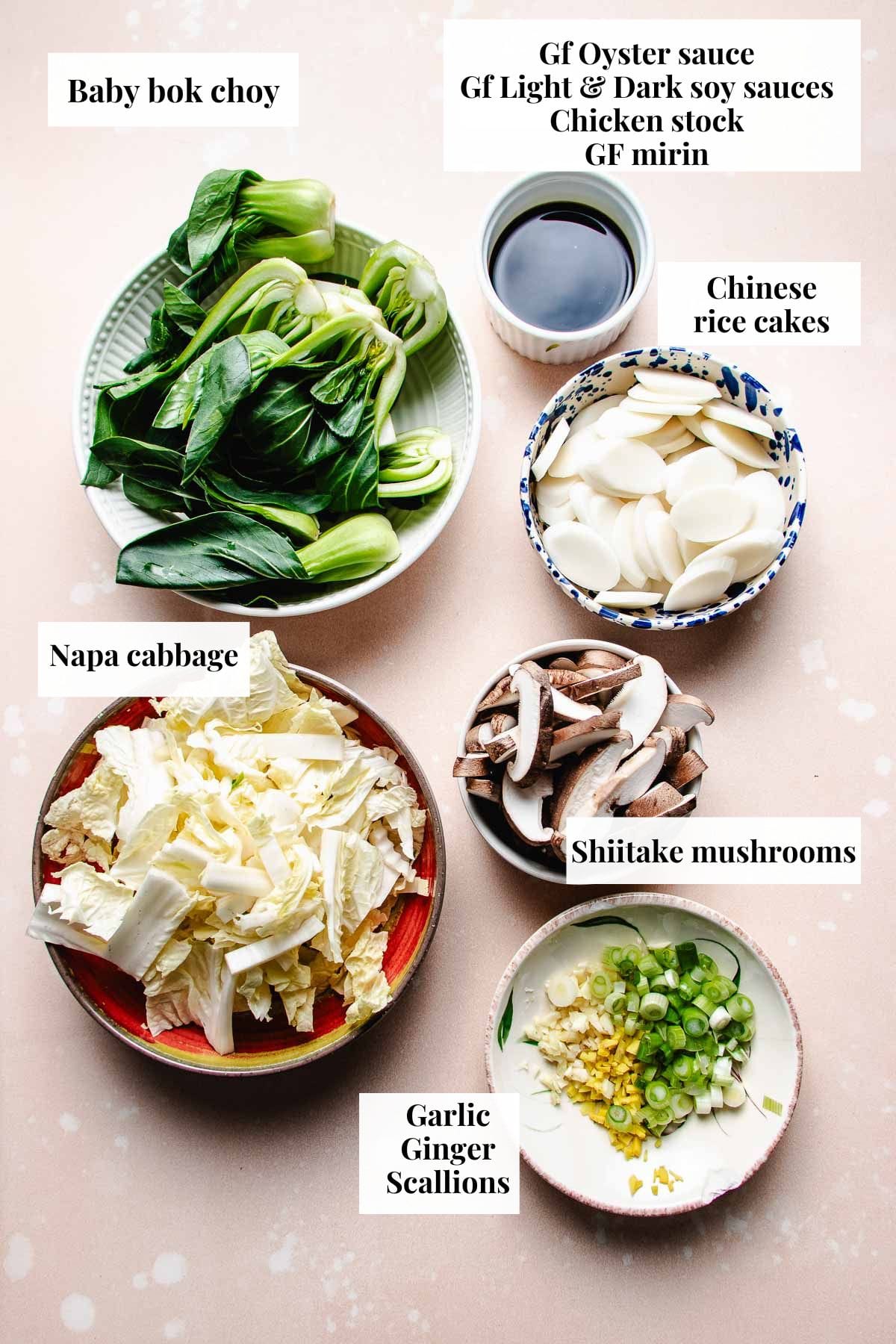
For the rice cake stir fry
- Chinese rice cakes: Also known as Shanghai rice cakes or nian gao. They are flat, oval-shaped, flat rice cakes (as opposed to a Korean rice cake, which is a cylinder) and can be bought fresh, vacuum-sealed in the refrigerator, or frozen.
- Shitake mushrooms: Use fresh or rehydrated dried shiitake mushrooms. They add a delicious umami savory flavor to this vegan dish.
- Garlic, ginger, and scallions: These form the aromatic flavor base of the stir fry. Reserve the green scallion parts until the end of cooking.
- Napa cabbage: Thinly sliced. Read more about how to cut napa cabbage here.
- Bok choy: Half them if using baby bok choy or quarter them if using large bok choy. Read more about how to cut bok choy here.
- Avocado oil: I like to use avocado oil for stir-frying because of its neutral flavor and high smoke point. Olive oil also works.
- Coarse sea salt
- Toasted sesame oil: Drizzle as a garnish.
- White pepper: Just a dash as a garnish. This gives an authentic Chinese flavor. Black pepper would also work.
For the sauce
- Oyster sauce: Adds a rich depth of flavor to the sauce. Choose gluten-free or use my vegetarian oyster sauce as needed.
- Light soy sauce: Or replace with coconut aminos if gluten and soy-free.
- Dark soy sauce: Or replace with coconut aminos if gluten and soy-free.
- Chicken stock: Or vegetable stock. Helps to moisten the dish when stir-frying.
- Gluten-free mirin: Optional to add a splash to add authentic flavor to the dish. You can also use Taiwanese michu or Shaoxing wine.
Tools:
- Because rice cakes are sticky and starchy, using a large (ideally 12-inch wide or larger) non-stick pan or wok is ideal when frying nian gao.
Substitutions and variations
- Added veggies: Sliced onions, carrots, or green onion to add additions to this dish.
- Different leafy greens: Chinese broccoli, snow pea leaves, spinach, yu choy, and tatsoi are great, authentic options for Chinese stir fry.
- Add proteins: Add your favorite protein, such as chicken, beef, shrimp, Chinese sausages, or tofu. For perfectly tender and juice meats in stir fry, read our posts on how to velvet chicken, beef stir fry marinade, and pork stir fry marinade.
How to cook Shanghai rice cake din tai fung style
This Chinese rice cake stir fry or chao nian gao is delightfully easy to make. Like any good stir fry, stir fried nian gao (rice cake) comes together quickly after some simple prep. Be sure to follow my tips for cooking perfectly chewy and sticky rice cakes every time!
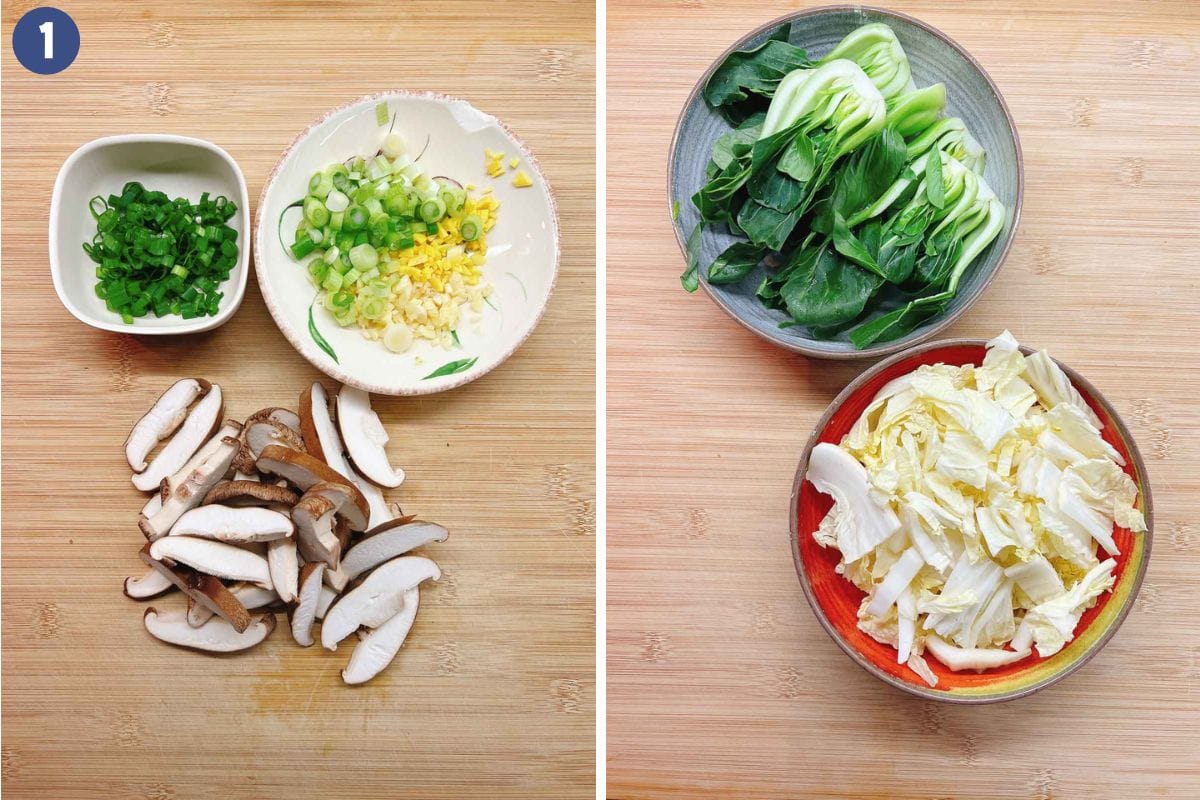
- Prepare the vegetables: Slice the shiitake and aromatics. Slice the napa cabbage stems into 0.5-inch slices and napa cabbage leaves into 2.5-inch sections. Halve or quarter the bok choy.
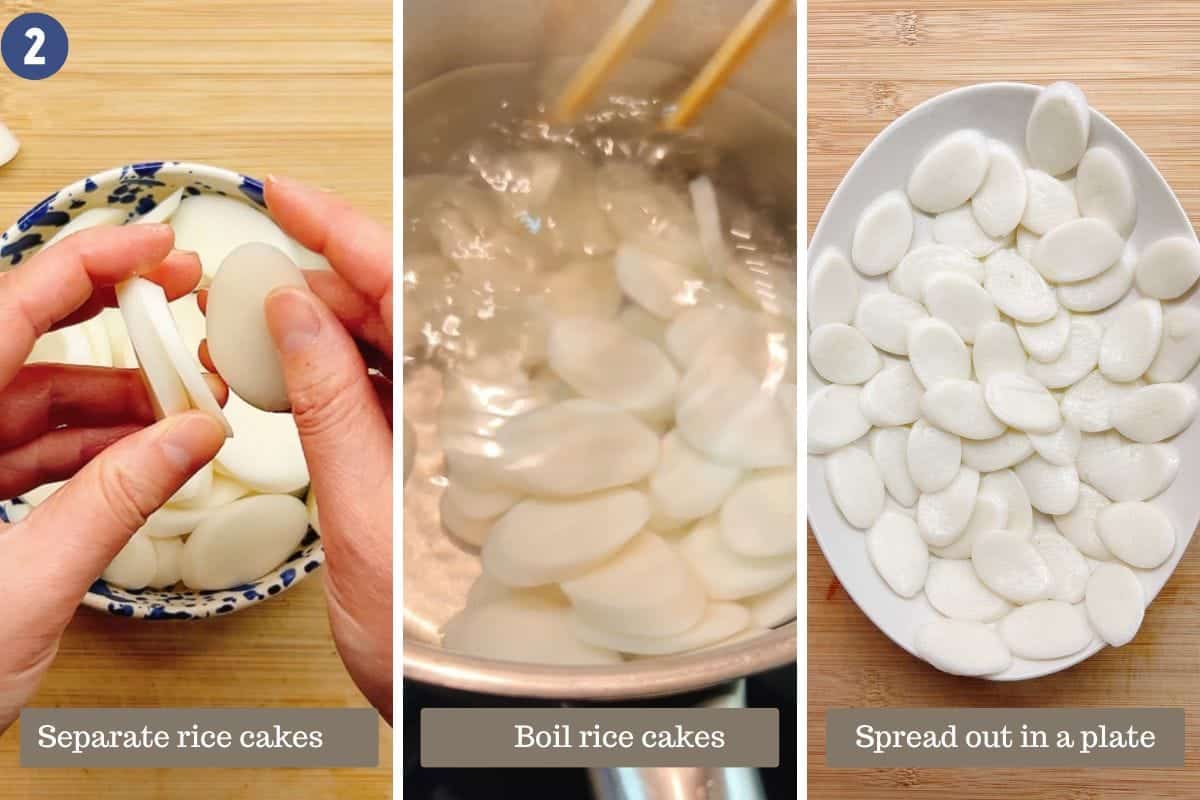
- Prepare rice cakes: Carefully separate the rice cake slices. Follow the package instructions to cook dried rice cakes until chewy. Scoop out the rice cakes, drain, and transfer them onto a large plate before gently tossing them in oil. Spread them out into a single layer.
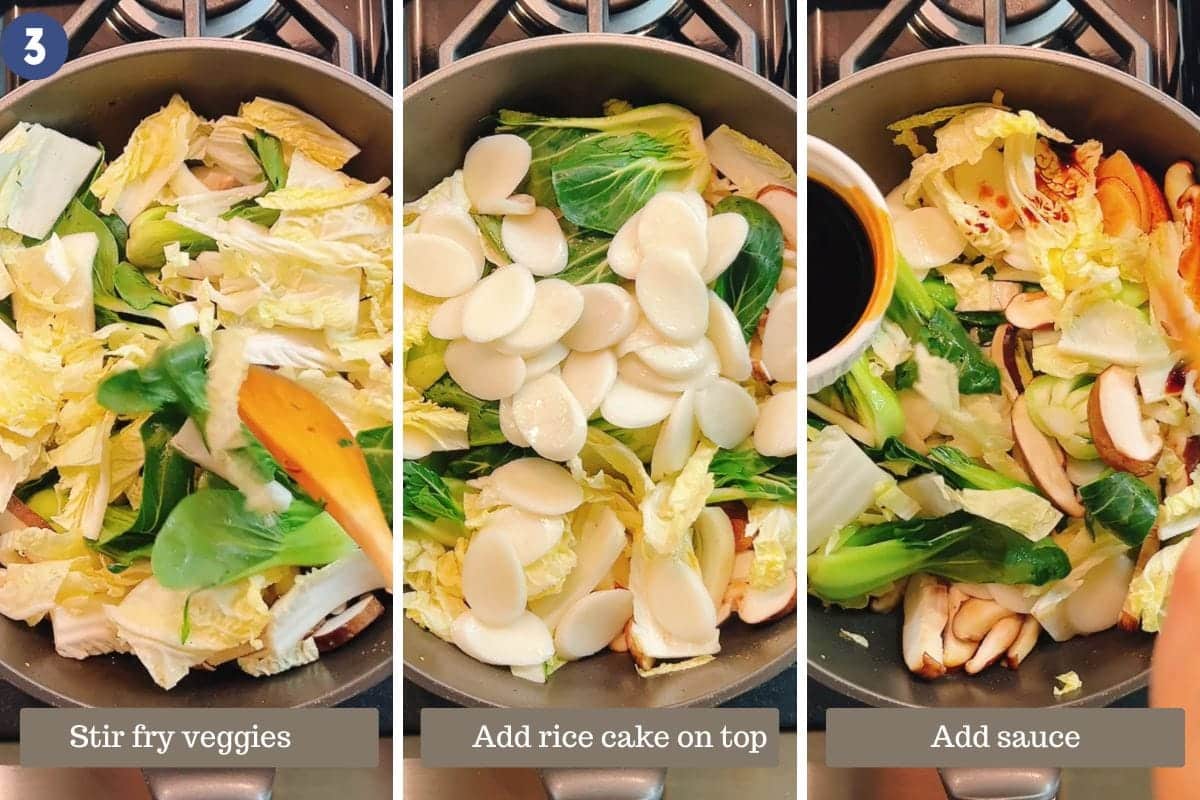
- Stir-fry: In a large saute pan, saute the aromatics first. Then add cabbage, shiitake, and bok choy to saute on high heat for 1 minute. Stir fry rice cake on top of the sauteed cabbage. Add the sauce, and then toss the rice cakes and other ingredients until the sauce thickens.
- Garnish and serve: Transfer to a large serving plate. Garnish with toasted sesame oil, a small dash of white pepper, and green scallion parts.
How to make ahead, store, and reheat
Stir fry rice cakes and greens is a great sliced rice cake recipe because the prep is so minimal. That being said, you could prepare the veggies and aromatics ahead of time for a shorter cooking experience. Here’s how to prep, store, and reheat this dish.
- Make ahead: Chop, rinse, and pat dry the cabbage and bok choy. Chop the aromatics.
- Storage: Once cooked, the rice cakes store well in the fridge for 3-4 days. You can also freeze them but the texture won’t be as soft and chewy after reheating.
- Reheat: Rice cakes will harden after refrigerated. To reheat, spread out the rice cakes evenly in a large saute pan and add some water (about ¼ cup), cover the pan and steam for 2 minutes over medium heat to rehydrate and soften the rice cakes again. Then stir fry to bring back the texture and temperature. The rice cakes should taste soft and chewy with a nice bouncy texture.
What to serve with stir fried rice cake
These vegan Chinese stir-fried rice cakes with greens are a wonderful side to any Asian-style meal. Pair them with a protein dish of your choice for a well-rounded meal. Or serve them with dumplings, which is a very traditional pairing during the Chinese New Year!
- Protein dishes: This dish pairs well with any protein. Try my chicken cabbage stir fry, Chinese ginger pork stir fry, or this air fryer salt and pepper tofu for a Chinese feast!
- Soup: Pair the rice cakes with Napa cabbage soup or Chicken hot and sour soup.
- Chinese dumplings for New Year: Serve with a tender and juicy beef wonton or try these gluten-free shrimp wontons. These crispy and chewy rice paper dumplings are also fantastic!
Expert tips
- Choose the Right Rice Cakes: Select Shanghai-stye rice cakes (Chinese rice cakes) for their distinct flat and oval disc shape.
- For Fresh/Refrigerated Rice Cakes: Boil fresh or refrigerated vacuum-sealed rice cakes directly without soaking or thawing.
- For Dried Rice Cakes: Soak dried, shelf-stable rice cakes in warm water for 20-30 minutes before cooking.
- Gently Separate Rice Cakes: Carefully separate each rice cake slice to ensure even cooking.
- Boiling Time for Rice Cakes: Boil for 3-4 minutes until they float and become chewy.
- Preventing Stickiness Post-Boiling: Coat boiled rice cakes with a small amount of oil and spread them in a single layer.
- Mise en Place: Prepare all ingredients beforehand for efficient cooking.
- Use a Large Non-Stick Pan: Non-stick pans prevent rice cakes from sticking due to starch release, making stir-frying easier.
FAQs
To cook Chinese rice cake, boil fresh or refrigerated cakes for 3-4 minutes until chewy. For dried cakes, soak in warm water for 20-30 minutes before boiling.
Boil rice cakes for 3-4 minutes. They’re ready when they float to the surface and have a chewy texture, not mushy.
Vegan Shanghai rice cakes (or Chinese rice cakes) are made from rice flour, tapioca starch, sugar, salt, and water, often using wet-milled Thai rice flour for a smooth and chewy texture.
A rice cake tastes subtly sweet and neutral, with a satisfying chewy texture. It absorbs surrounding flavors well, making it versatile in various dishes, like this stir fry recipe with rice cakes.
Boil the rice cakes just until they float to the top and have a chewy texture. Overboiling can make them mushy. Coating them in oil after boiling also helps prevent sticking and mushiness.
More Chinese one-pan meals you might like
If you love this vegan nian gao stir fry, give some of these other classic Chinese dishes a try!
- Din Tai Fung rice cake with chicken with chewy round rice cakes and chicken in a flavorful sauce, inspired by the popular restaurant. (coming soon)
- Steak fried rice with veggies in a juicy beef stir-fry marinade.
- Cantonese beef chow mein with saucy beef, crisp veggies, and sweet potato chow mein.
- Din Tai Fung fried rice recipe with shrimp and egg-fried rice in secret seasoning.
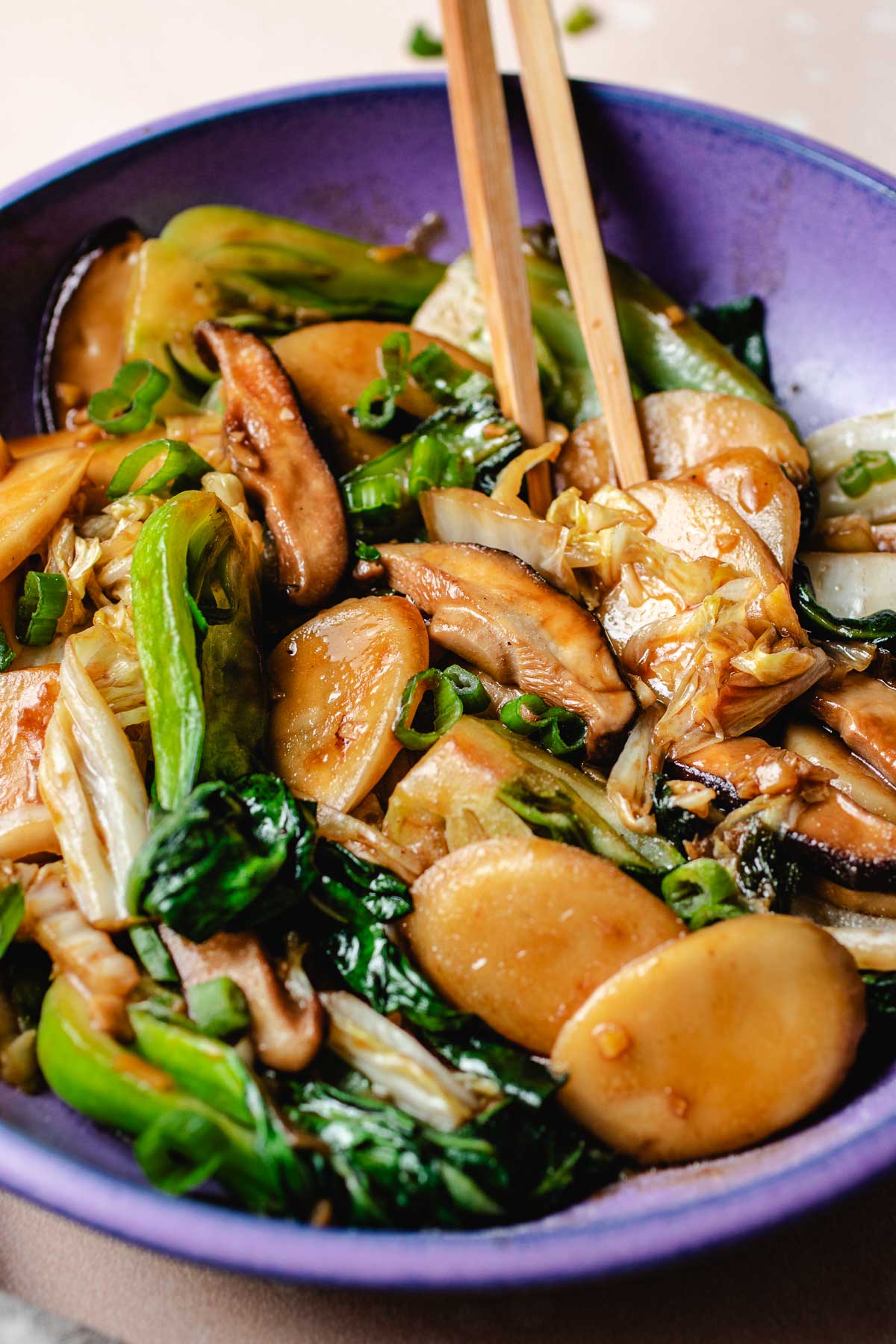
Shanghai rice cake recipe with napa cabbage and bok choy

Video
Ingredients
- 8 oz Chinese rice cakes oval, sliced, flat-disc shape also known as Nian gao
- 4 oz fresh shiitake mushroom 4 large caps
- 0.5 oz garlic 3 large, finely minced
- 0.2 oz ginger finely minced
- 2 bulb scallions sliced and separate white and green parts
- 6 oz napa cabbage
- 6 oz baby bok choy 5 dwarf baby bok choy, halve or quarter or diced for larger ones
- 2 tbsp avocado oil or olive oil, divided
- ¼ tsp coarse sea salt
- Drizzle Toasted sesame oil
- A small dash white pepper
Sauce:
- 1.5 tbsp oyster sauce or vegetarian oyster sauce
- 1 tbsp light soy sauce or coconut aminos
- ½ tbsp dark soy sauce or coconut aminos
- 1 tbsp chicken stock or vegetable stock
- ½ tbsp gluten-free mirin or Taiwanese michu, Shaoxing wine, optional
Instructions
- Prepare vegetables: Slice the shiitake and prepare the garlic, ginger, and scallions. Separate the white and green parts.
- Dice the napa cabbage stems to thin slices, about 0.5 inch slice and napa cabbage leaves to 2.5 inch sections. Halve or quarter the bok choy. Rinse them well, drain, and pat dry.
- Prepare rice cakes: Use your hands to carefully and gently separate each piece. Follow the package instructions. My rice cakes are from the refrigerated aisle and the instructions say to boil them in hot boiling water for 3 minutes.
- Bring a pot of water to boil and add the rice cakes. Stir the water periodically to ensure the rice cakes don’t stick to the bottom of the pan. After, the rice cakes will flow to the top and have a chewy texture that’s not mushy,
- Use a strainer to scoop out the rice cakes, drain, and transfer them into a large plate. Add 0.5 tbsp oil and gently toss the rice cakes to prevent them from sticking to each other. Spread them out into a single layer. This is important otherwise the rice cakes will stick to each other and make it harder to cook evenly in stir fry.
- To stir fry: Use a large saute pan – add 1.5 tbsp oil, saute ginger, garlic, white scallion parts for 10 seconds over medium heat.
- Then add cabbage, shiitake, and bok choy. Turn heat up to high and saute for 1 minute. Season with 1/2 tsp salt. Keep the veggies crisp because we are going to cook them further so don’t overcook them at this point.
- Lower heat to medium-high. Return rice cakes to the pot and place them directly on top of the cabbage. Add the sauce. Continue stir frying, scooping, and tossing the rice cakes for 3-4 minutes, or until the sauce thickens. The rice cake will release starch further to help thicken the sauce.
- To serve: Turn off the heat. Transfer to a large serving plate. Garnish with toasted sesame oil, a small dash of white pepper, and green scallion parts.
Notes
- To reheat from the leftovers, the rice cakes will harden after refrigeration. To reheat, spread out the rice cakes evenly in a large saute pan and add some water (about ¼ cup), cover the pan and steam for 2 minutes over medium heat to rehydrate and soften the rice cakes again. Then stir fry to bring back the texture and temperature. The rice cakes should taste soft and chewy with a nice bouncy texture.
- Pay attention to the vegetable quantity. Don’t use too much napa cabbage as it leaks more water than bok choy. Balance is the key.
- I intentionally used a higher vegetable ratio to rice cake than most stir fried rice cakes recipe out there to keep this dish more vegetable focused. If you prefer a bigger rice cake presence in the dish, increase the rice cake quantity to 10-12 oz.
- Napa cabbage naturally will release more moisture when you cook it. If, however, you feel your stir fry needs a bit more liquid, add 1-2 tbsp water or stock to the pot.
Nutrition
Nutrition information is automatically calculated, so should only be used as an approximation.
Made a dish and loved it? Please rate the recipe and leave a comment in the section below! It helps my blog grow organically, allowing me to continue sharing free and awesome content with you. Thank you!
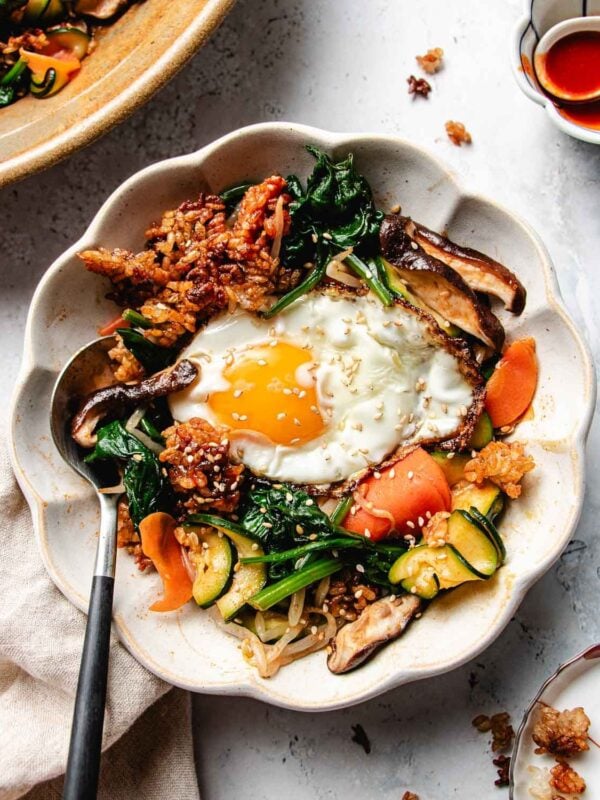
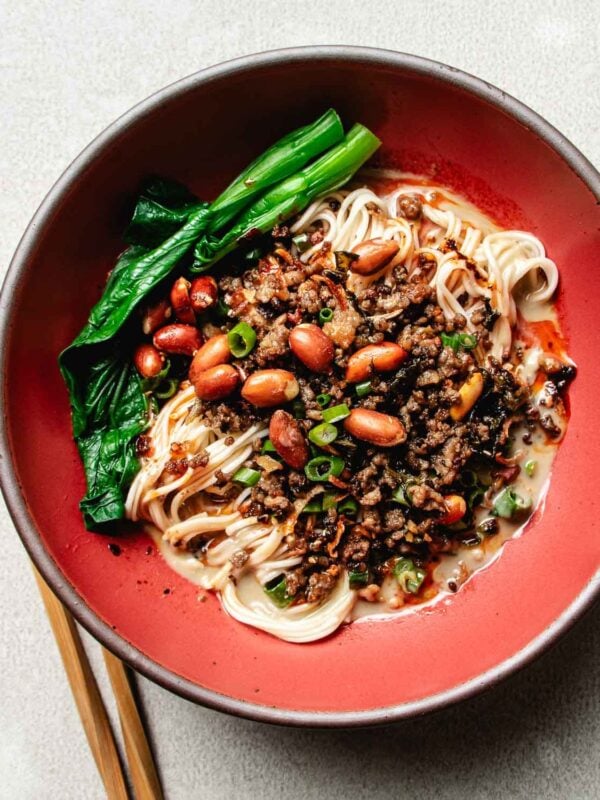
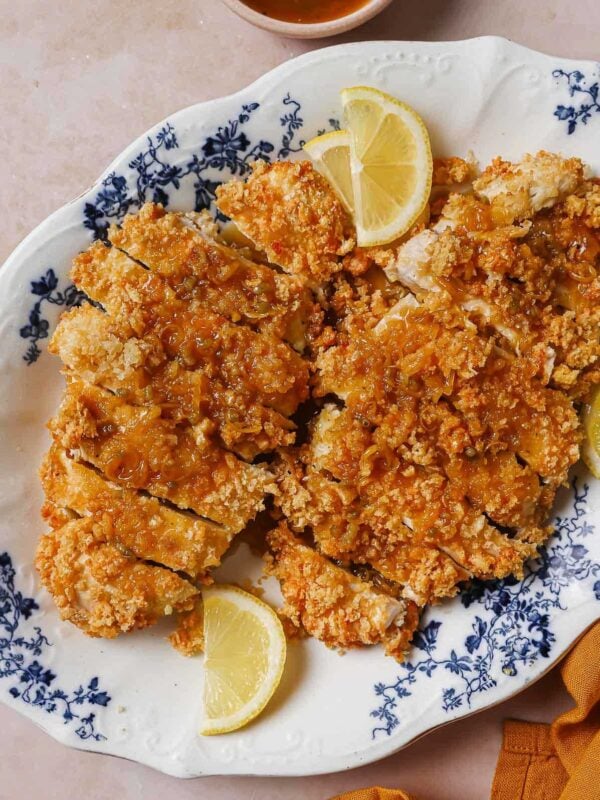
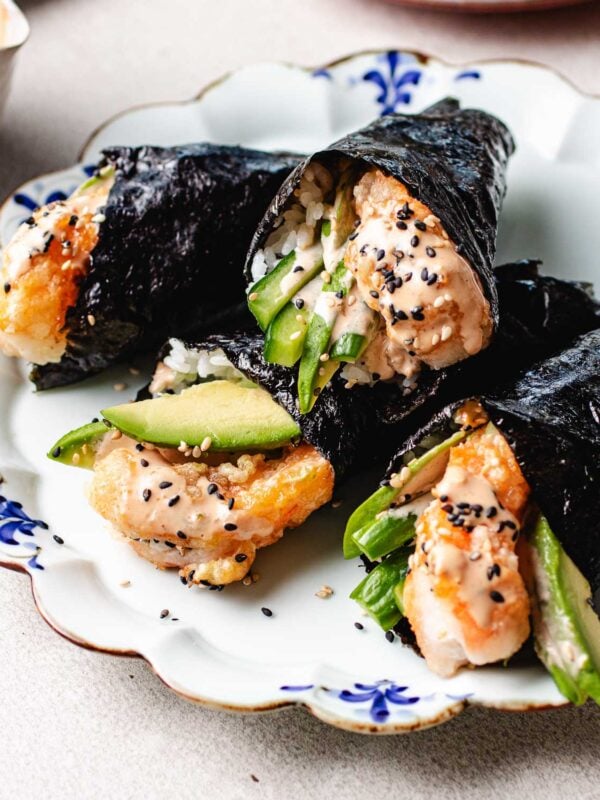









Very easy and one of the best dishes I have had! Thank you for sharing all your recipes. Every one I try is wonderful.
Thank you so much!
Din tai fung is my favorite restaurant, so being able to make one of my favorite dishes from there makes me happy. I can’t get enough of this dish!
Me too! Ha! I got tired of not able to get a reservation in New York so making it myself at home then!
I’m always looking for new recipes for Lunar New Year and this hit the spot. I love the symbolism but I love that it’s a quick simple dish that can be eaten throughout the year! Great tip about oiling the rice cakes. I’ve always had trouble cooking them and they came out PERFECT with this recipe!
You are the best. Thanks so much, Sam.